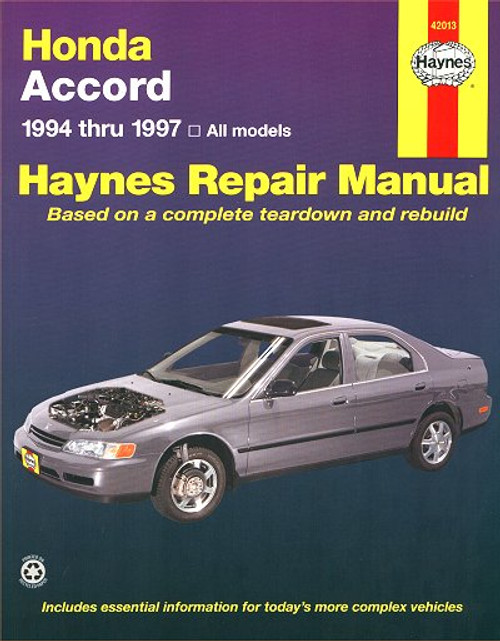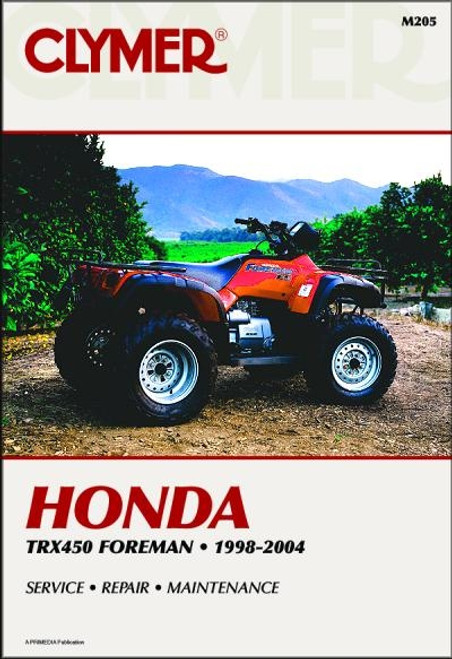This DIY repair and service manual by Haynes, covers all 1998-2002 Honda Accord models. The perfect companion for do-it-yourself Accord owners who like to maintain and service their own vehicles. This book covers from basic scheduled maintenance tasks, such as oil and filter change, to advanced jobs such as brake system service, electrical system troubleshooting, and engine repairs or rebuild.
Book Excerpt: 1998-2002 Honda Accord Repair Manual GENERAL ENGINE OVERHAUL PROCEDURES
BODY
Subject: 1998, 1999, 2000, 2001, 2002 Honda Accord service, maintenance, repair. ISBN-10: 1563925389 | ISBN-13: 9781563925382 | Haynes 42014
Book Excerpt: 1998-2002 Honda Accord Repair Manual GENERAL ENGINE OVERHAUL PROCEDURES
OIL PRESSURE CHECK (Refer to illustrations 2.2a and 2.2b)
- Low engine oil pressure can be a sign of an engine in need of rebuilding. A "low oil pressure" indicator (often called an "idiot light") is not a test of the oiling system. Such indicators only come on when the oil pressure is dangerously low. Even an original pressure gauge in the instrument panel is only a relative indication, although it's much better for driver information than a warning light. An accurate test can only be performed with a mechanical (not electrical) oil pressure gauge. When used in conjunction with an accurate tachometer, the engine's oil pressure performance can be compared to the manufacturer's Specifications for that year and model.
- Locate the oil pressure indicator sending unit (see illustrations).
- Remove the oil pressure sending unit and install a fitting which will allow you to directly connect your hand-held, mechanical oil pressure gauge. Use Teflon tape or sealant on the threads of the adapter and the fitting on the end of your gauge's hose.
- Connect an accurate tachometer to the engine, according to the tachometer manufacturer's instructions.
- Check the oil pressure with the engine running (full operating temperature) at the specified engine speed, and compare it to this Chapter's Specifications. If it's extremely low, the bearings and/or oil pump are probably worn out.
BODY
TRUNK LOCK CYLINDER (Refer to illustration 14.6)
- Open the trunk and look upward through the trunk lid access hole behind the right taillight. Remove the lock cylinder rod from its clip and remove the lock's mounting bolt (see illustration). On models so equipped, disconnect the electrical connector from the lock.
- Twist the lock about 45 degrees and remove it from the trunk.
- Installation is the reverse of removal.
TRUNK RELEASE AND FUEL DOOR CABLE | REMOVAL AND INSTALLATION (Refer to illustrations 15.2 and 15.8)
- Refer to Section 14 for removal of the trunk latch and disengagement of the cable from the latch.
- Inside the trunk, remove the spare tire cover, left-side panel and side storage pocket for access to the fuel door cable end. Twist the fuel door latch cable end one quarter turn and pull it from the fuel door housing (see illustration).
- Remove the rear seat bottom as described in Section 27. On coupe models, both seat back and bottom must be removed.
- Pry up the driver's side door sill covers (only one cover on coupe models). On four-door models, remove the center door pillar's lower trim panel.
- Peel back the carpeting to access the release cable. Open all of the clips holding the cable to the body.
- Pry open the upper lid around the lock cylinder in the cable release lever housing next to the driver's seat. Insert your key and rotate the lock cylinder hard counter-clockwise until the cylinder can be withdrawn with the key.
- At the side of the release lever housing that faces the seat, remove the small plastic cover and loosen the bolt, using a socket and extension through the hole where the lock cylinder was. Push the release lever housing rearward to free it from the bolt.
Subject: 1998, 1999, 2000, 2001, 2002 Honda Accord service, maintenance, repair. ISBN-10: 1563925389 | ISBN-13: 9781563925382 | Haynes 42014
TABLE of CONTENTS:
- Introduction: Vehicle identification numbers; Buying parts; Maintenance techniques, and more.
- Tune-up and routine maintenance
- Four-cylinder engine
- V6 engine
- Engine and overhaul procedures
- Cooling, heating and air-conditioning systems
- Fuel and exhaust systems
- Engine electrical systems
- Emissions control systems
- Manual transaxle
- Automatic transaxle
- Clutch and driveaxles
- Brakes
- Suspension and steering systems
- Body
- Chassis electrical system
- Wiring diagrams










